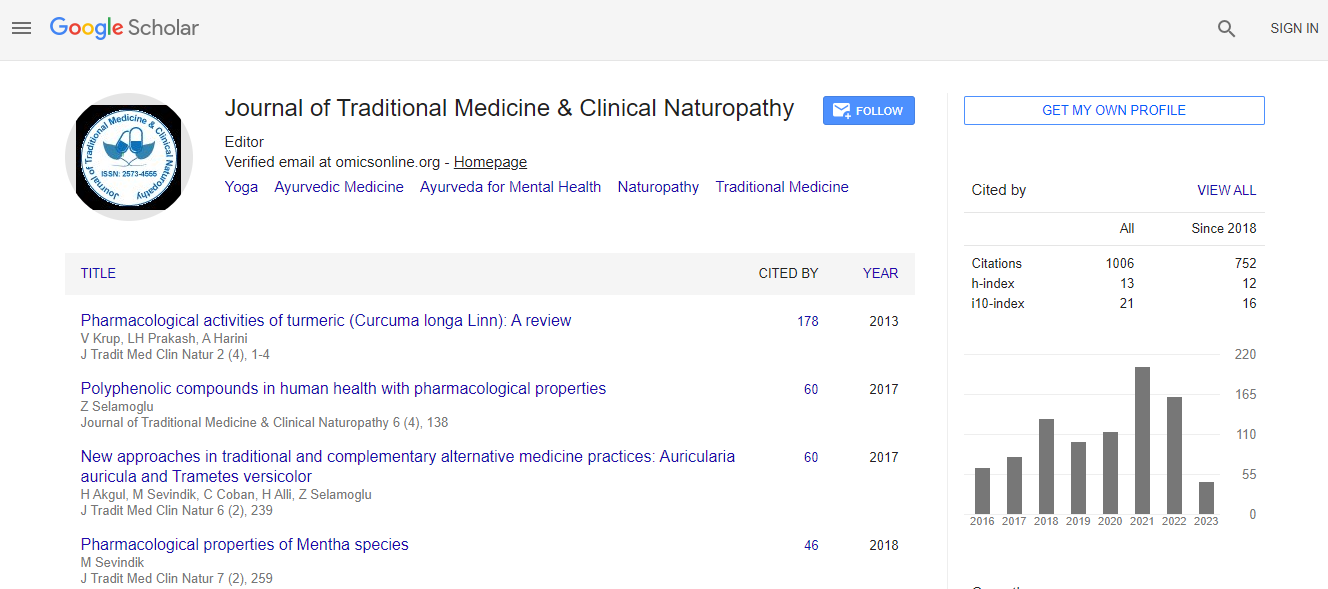Research Article
Antidiabetic Potential and its Relationship with Polyphenol and Degree of Polymerization in Acalypha indica Linn Leaves
| Prakash R Itankar1*, Akash P Jaiswal2, Prashant R Verma2, Sumit K Arora2 and Arun T Patil1 | |
| 1Assistant Professor, Department of Pharmaceutical Sciences, Pharmacognosy and Phytochemistry Division, Rashtrasant Tukadoji Maharaj Nagpur University, Amravati Road, Nagpur- 440 033, Maharashtra, India | |
| 2Department of Pharmaceutical Sciences, Pharmacognosy and Phytochemistry Division, Rashtrasant Tukadoji Maharaj Nagpur University, Amravati Road, Nagpur- 440 033, Maharashtra, India | |
| Corresponding Author : | Prakash R Itankar Department of Pharmaceutical Sciences Pharmacognosy and Phytochemistry Division Rashtrasant Tukadoji Maharaj Nagpur University Amravati Road, Nagpur- 440 033, Maharashtra, India Tel: +91-712-2550324 Fax: +91-712-2500355 E-mail: pri_200672@rediffmail.com |
| Received November 21, 2011; Accepted December 20, 2011; Published December 23, 2011 | |
| Citation: Itankar PR, Jaiswal AP, Verma PR, Arora SK, Patil AT (2012) Antidiabetic Potential and its Relationship with Polyphenol and Degree of Polymerization in Acalypha indica Linn Leaves. J Homeopat Ayurv Med 1:102. doi: 10.4172/2167-1206.1000102 | |
| Copyright: © 2012 Itankar PR, et al. This is an open-access article distributed under the terms of the Creative Commons Attribution License, which permits unrestricted use, distribution, and reproduction in any medium, provided the original author and source are credited. | |
Abstract
Acalypha indica commonly known as Kuppi belongs to family Euphorbiaceae. Traditionally the plant used as a laxative, anthelmintic, cathartic and the juice is used as a speedy emetic for children and expectorant. It is used by tribal areas of Maharashtra State as rheumatic arthritis and as antihyperglycemic. However, no scientific data is available to validate the ethnobotanical claim. Keeping the above information in view, the present study has been designed to evaluate its antidiabetic activity. In the present study, hydroalcoholic extract of leaves and its fractions were studied for its anti diabetic potential in alloxan induced diabetic rats. The poly phenolic, flavonoid and flavanone contents of hydroalcoholic extract and its fractions were also determined and correlated with its anti diabetic activity.
The experimental data indicated that the hydroalcoholic extract and its chloroform soluble fraction has significantly lowered the elevated blood glucose levels by 36.82% and 61.52% respectively at dose level of 400 mg/kg per oral after 7 days as compared to diabetic control. The poly phenolic and flavonoid content of hydro alcoholic extract and its chloroform soluble fraction were found to be 7.9 ± 0.20 mg and 1.14 ± 0.21mg (gallic acid equivalent/ g extract) and flavonoid content 2.02 ± 0 .50 mg and 0.56 ± 0.003mg (rutin equivalent/g extract) respectively.
The increased anti diabetic potential of chloroform fraction over hydro alcoholic extract is due to its partial purification achieved by fractionation which resulted in increase in degree of polymerization and segregation of secondary metabolites.

 Spanish
Spanish  Chinese
Chinese  Russian
Russian  German
German  French
French  Japanese
Japanese  Portuguese
Portuguese  Hindi
Hindi 
